This bridge is a direct replacement on Gibson guitars with an ABR-1 bridge or with our special conversion post on guitars equipped with the Nashville bridge. The body of this bridge is CNC machined from a billet of Cold Rolled alloy steel under rigid quality control standards at every level of production. This is the only alloy Steel bridge available. Gibson and the other aftermarket bridges are cast from a zinc alloy, brass or aluminum which causes heavy dampening to the critical overtones that support the fundamental.
 A Little History
This bridge is a direct replacement on Gibson guitars with an ABR-1 bridge or with our special conversion post on guitars equipped with the Nashville bridge. The body of this bridge is CNC machined from a billet of Cold Rolled alloy steel under rigid quality control standards at every level of production. This is the only alloy Steel bridge available. Gibson and the other aftermarket bridges are cast from a zinc alloy, brass or aluminum which causes heavy dampening to the critical overtones that support the fundamental.Gibson has manufactured some of the most beautiful guitars in history but their tone, especially of the models made in the last 40 years, drives me crazy. The bass response is too muddy and on the majority of instruments is fuzzy like a mini fuzz face is on. The high end is harsh and brittle so moving from wound strings to plain strings is very unbalanced. The sustain is really quite poor. This problem is masked by the use of strong P-90 or humbucking pickups. If Fender style single coils were used, the lack of sustain would become very apparent. "Tone" is all about overtones or the harmonic series that follows and rides with the fundamental. The choice of bridge material is critical for the simple reason that every note played is influenced by the bridge. In the early days of solid body electric guitars especially at Gibson the only part that really mattered to designs were the pickups. The ABR-1 bridge introduced in 1954 was cast from zinc because it was cheap to produce and nobody thought it made one bit of difference. Aftermarket bridges have copied the use of zinc without any thought of how can this be improved. In the 70's when CBS took over Fender they threw out Leo's steel strat bridge and changed to the one piece cast zinc (Mazac) bridge to cut cost. The result was the worst sounding strats produced by Fender. Zinc simple should not be used as a bridge material. Brass has been used because it has "more mass", aluminum because it has "less mass". "Mass" is not the property of the bridge marial that matters. But it is easy to measure for those who do not understand vibrations. No material maintains the energy delivered to the string while maintaining a full musical frequency response better than steel. Our ABR-1 is the most significant improvement you can make to a Gibson styled instrument. Just like with our Strat and Tele parts, I am not interested in repeating mistakes of the past, only real audible improvement for all players at any level.
Construction and Specifications
Again the bridge body is made from cold rolled medium carbon steel. Rigid quality controls are checked thoughout the bodies production. The body is nickel plated to mil spec standards to maintain all critical dimensions. The intonation screws, mounting studs, and thumbwheels are stainless steel. It is the quality control in production and plating that allows the intonation screws to be a press fit into the body. The saddles are machined from the same brass bar stock we make our Tele saddles before being nickel plated. They are direct replacement on our ABR-1 and Gibson ABR-1 bridges.
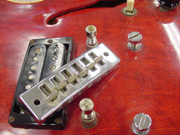 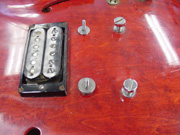 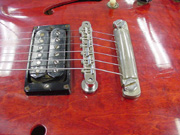
67 ES335 which had a hideous Schaller bridge installed at some point in its life. We made a special stud set to install a Callaham ABR-1.
What you will hear with the change to steel is a low end that is tight but full. The fuzz should be gone, if it is not, you need to look at your pickups. The tone will be balanced correctly when moving from wound to plain strings. The plain strings will be full without the harsh high end spike. Sustain is improved substantially making vibrato childs play. Many of you have also been victim to the collapsing of the stock bridge from string pressure. You will not collapse our steel bridge. The rigidity of the steel will allow the use of heavy string gauges and again maintaining the strings energy far better than zinc, aluminum, or brass. Since the mid 80's Gibson started equipping the majority of their models with the Nashville bridge. This bridge which was marketed as an improvement is in fact a step backwards. The honeycombed zinc casting is weak and the extra width of the bridge causes problems with obtaining the correct back angle to the tailpiece. Our Nashville conversion kit allows the seamless replacement of a Nashville bridge to our ABR-1 bridge. With this change you not only gain the undeniable tonal improvements but the vintage look without any modification to the instrument. On the subject of looks, today's ABR-1 bridges have none of the handworking and tapering of the ends of the bridges from the mid/late 50's. We specifically machined the ends to a taper and through the course of hand polishing recreate the look of the late 50's bridge bodies. The stainless steel thumbwheels are thinner like the 50's model compared to today's production.

Callaham Thumbwheel on Left. Modern Gibson Thumbwheel on Right. Our Thumbwheel are based on Vintage Thumbwheel which are thinner.
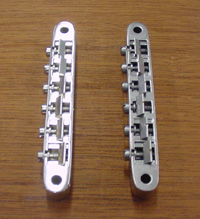
Non-Distressed vs Distressed Callaham ABR-1 bridge
Gibson Guitars are not cheap. $2,000 gets you the budget models and when you look at the price of Historics they are out of reach for the average hardworking professional or amateur musician. Yet all these guitars have a bridge that maybe costs $8.00 to produce. The Historics especially try to dazzle you with looks and marketing. We had over 20 Historics in when we were doing the prototypes, all of which sound night and day better when we changed the bridges. It had been several years since I played a real "burst", when we brought in two and changed the bridges it left us speechless. Looks and price does not influence me, only sound. But if you really want to improve the sound of your Gibson I strongly suggest our bridge. You must get past looks and price and listen to the overtones around the fundamental. For those with a Nashville bridge, be ready for a tremendous improvement. If you own a real PAF equipped instrument, you need to hear what it really can produce.
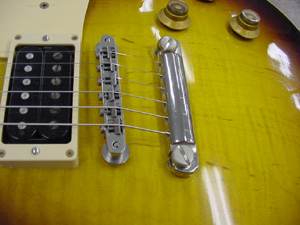
Distressed Callaham ABR-1 on a Murphy Historic
Installation...
We do not provide formal instructions on the installation. We assume you know what you are doing. The saddles should be notched by a pro. Most guitars do not have the optimum string spacing and pole alignment with the notch in the center of the saddle. Therefore it is best to notch the saddles for each individual guitar. But if your instrument can be set-up with center notching, we can do it for a $20.00 upcharge. When installing Nashville Conversion studs, the 6-32 threaded section must be protected. Pressing or tapping directly on that section can bend it. If you bend the stud, that is an indication you should not be working on your guitar.
 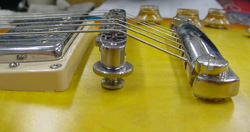
A Callaham Nashville Conversion on a L.P. Standard Faded
| 


